Symmerian Empire: Difference between revisions
No edit summary |
No edit summary |
||
| Line 14: | Line 14: | ||
|year_end = 1305 CE<sup>1</sup> | |year_end = 1305 CE<sup>1</sup> | ||
|image_flag = [[File:MakedonFlag.png|300px]] | |image_flag = [[File:MakedonFlag.png|300px]] | ||
|image_map = [[File: | |image_map = [[File:MakedonianEmpire1.png|300px]] | ||
|image_map_alt = | |image_map_alt = | ||
|image_map_caption = Makedonian Empire at it's greatest extent, circa 692 CE | |image_map_caption = Makedonian Empire at it's greatest extent, circa 692 CE | ||
Revision as of 01:56, 17 August 2021
Makedonian Empire Makedonsko carstvo | |
|---|---|
| 556 BCE–1305 CE1 | |
|
Flag | |
 Makedonian Empire at it's greatest extent, circa 692 CE | |
| Capital | Parilla |
| Common languages | Ancient Makedonian |
| Religion | Zobethos |
| Demonym(s) | Makedonian |
| Government | Absolute Monarchy |
| King | |
• 556 - 591 BCE | Epikharmas |
• 1288 - 1319 CE | Myrtilos |
| Historical era | Antiquity to Medieval |
• Established | 556 BCE |
• Dissolved | 1305 CE1 |
| Currency | Drachma |
| Today part of | Syara Ruvelka Allamunnika Delkora Quenmin |
| |
The Makedonian Empire (also called Makedonian Realm or simply Makedon) was an ancient kingdom in Syara before rising to become an empire and one of the biggest powers in ancient Siduri. Makedon was originally founded by Epikharmas in 556 BCE, who established the Kineasan Dynasty that would serve as the Makedonian monarchy until 1987 CE at the end of the Refusal War. Home to the Ancient Makedonians, Makedon in it's earliest state was centered in northern Syara, bordered by Ruvelka to the east, Galania to the south, and Scitaria to the west.
Before the 3rd Century BCE Makedon was one of several competing nations within Syara, distinct for it's professional and well trained army. In 246 BCE Orestes II ascended to the throne and began a campaign of conquest across the rest of Syara. Between 238 to 227 BCE Orestes conquered much of Ruvelka, Mansuriyyah, and Arkoenn, while defeating the Sardaran and what remained of the Erani Empire. Makedon continued to slowly expand over the course of several centuries, leading to conflicts with the northern Bosrei, the Chalna Empire, and the various steppe nomads of central Siduri. Friction with the Hannashka and the Hayern Migration between the 3rd and 5th Century CE preceeded the eastward expansion of the Empire into Quenmin under Deinokrates III, which led to conflict with the Sabrian Empire in what became known as the Sabrian Wars, during which the Empire reached it's territorial apex.
The outbreak of the Burning Plague in 825 CE is generally considered to mark the decline of Makedon. Syara lost approximately 25% of the population, crippling the Empire's taxation system and military manpower and leading to a demographic crisis. Weakened by its depleted population, the Empire suffered a series of military defeats against the Rideva Empire of southern Siduri, resulting in the loss of Knichus in the early 10th Century. The Âu Lạc Rebellion, brought an end to Makedonian rule over Quenmin, while the rise of the Arkoennite Empire reduced Makedonian influence in central Siduri further. The rise of the RAwwadid Sultunate followed by Makedonian defeat in the Battle of Tell Saqara ended Makedonian dominion over Mansuriyyah in the early 13th Century, reducing Makedon's borders to the Kurilla and Matra Mountains in Ruvelka. The Arkoennite invasion of Ruvelka followed by the Arkoennite victory at the Battle of Nemaro effectivley ended Makedon's independence and is often cited as the end of the empire, after which Makedon became a tributary state to the Arkoennites.
Makedon's influence was felt throughout Siduri. At it's peak, the Empire ruled over approximately 10 million square kilometers of territory, and presided over 90-120 million inhabitants. The prominence of the Empire spread Hellenic culture throughout Tyran, including the Indo-Hellenic Arosiananda Kingdom and Hellenic migrants in the Liúşai League. Considerable debate reigns in regard to the Fall of the Makedonian Empire and the nature of the Empire itself. Among these debates is the moniker of "Empire", the role of Makedonian culture, and its impact on its vassals.
